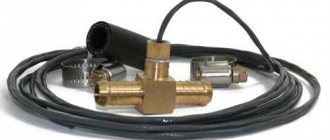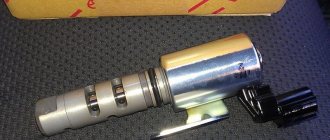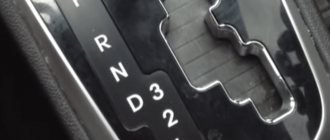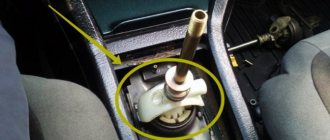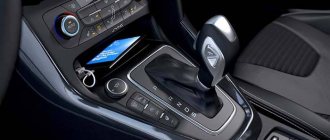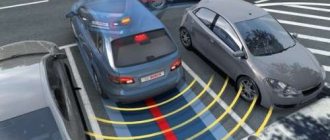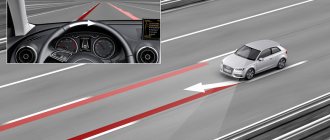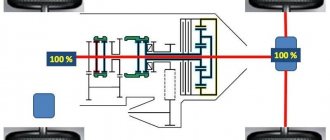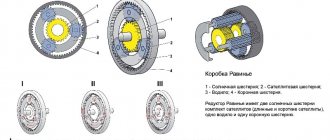Automatic transmission and Parking mode Automatic transmission gives rise to many myths and fictions.
And they all involve parking! It’s not uncommon for car enthusiasts to make mistakes that lead them to a car service center to repair their automatic gearbox. Electric scooters, Car video recorders. Discounts
Automatic transmission parking mode
Automatic transmission parking mode. Myths
Some people think that under no circumstances should you leave the car in the parking lot, but must always put it in “neutral gear” and “handbrake”. Others say that it’s just super convenient and always use it, while others say that when “parking” the brake pads are blocked at the front or rear, so the car is fixed! But where is the truth, how does a car work when transferred to this position, let’s figure it out...
Automatic transmission parking mode. Myths
To begin with, I would like to immediately tell those who assure you that you cannot set this mode in a parking lot! Guys, this is not true. The word “Parking” is originally English; if translated, it means “parking”. Thus, manufacturers hint that when stopping, you need to turn on this particular mode. This is a kind of putting the car into gear, compared to a manual transmission.
If the car is parked and you are towing it
This happens due to inexperience; many may start towing not in a neutral position, but in “parking”. The car will roll with “force”, but clicks will be heard!
- Nothing bad will happen, the clicks mean that the lever will jump from tooth to tooth, but the structure will not be damaged, details will be below in the video
- However, I still strongly do not recommend you to tow a car in this mode, it’s still not entirely correct! You need to put the gear in neutral, or call a tow truck.
RESULT. “PARKING” – does not block the brake pads, it is NECESSARY to install it, because you will not start your car! Occasionally you also need to press the brake pedal (not all manufacturers, but this exists).
Now there is a very useful video, it tells how it all works from the inside, be sure to watch it.
That's all, sincerely your AUTOBLOGGER.
Similar news
- Robot (manual transmission) – robotic gearbox. What it is? ...
- Hardware or partial oil change in automatic transmission. How to do it right...
- Automatic transmission adaptation reset. We will consider KIA and Hyundai
Add a comment Cancel reply
Automatic transmission in the parking lot. So pads or not?
I will immediately answer the second myth - namely, that the car blocks the front or rear brake pads. This is also not true, the braking system of your car is not involved in “parking”, it has nothing to do with locking the machine. Although it seems to be logical.
This is also not done for the reason that in winter the pads can simply freeze to the surface of the disc, so they looked for another solution at the transmission level and you know, they found it.
How does blocking happen?
Now I’ll remember a little about the manual transmission. So, in “mechanics” there is a wonderful opportunity to put the “car in gear”, that is, you do not use the parking brake, do not use other locking methods, but simply leave it - say, in “first gear” and the car will not roll anywhere.
How does blocking occur in a manual transmission?
But why? Yes, because the mechanics are “rigid engagement”, that is, the gears of the “box” are rigidly connected to the clutch disc – the flywheel and then the engine. While the power unit is not working, there will be no movement! Of course, you can open this circuit and if the car is standing downhill it will roll, just put it in “neutral”. Thus, you cut off the transmission from the motor, and it can “rotate the shafts” without it!
Hydraulic coupling automatic transmission
The automatic transmission works differently. It does not have a clutch in the mechanical sense; here the torque is transmitted using a torque converter, but it does not have a rigid engagement (read here). Therefore, you can’t leave the automatic transmission in gear, it just won’t work!
But they say that “parking” is just a blocking of the transmission, but how does this happen?
Correct automatic parking
Now you probably want to know how to park properly. There's nothing complicated about it. The main thing is to remember the procedure, step by step. Since a wrong step, which you make once and then repeat several times, will most likely cause the parking mechanism to fail. And you will have to go to a service station to patch this part.
I advise you to use three rules of perpendicular and parallel parking, which I will discuss in the following blocks.
Method 1: Perpendicular parking on the right
When parking, you must follow the same rules as on the highway. You need to stay on the right side. Here's how to park on the right:
Read
12 inexpensive cars with automatic transmission
- Drive past parked cars, calculating the distance between them and look for an empty space. During this time, your vehicle speed should be kept to a minimum.
- Press the brake pedal when the rear bumper is level with the left side of someone else's car already standing in its place.
- Stop the vehicle completely and switch the automatic transmission to the “Reverse” mode.
- Look in the right mirror to prevent your and someone else's car from getting dangerously close.
- Turn the steering wheel as far as possible to the right and half a turn to the left. Press the gas pedal.
- Slowly release the steering wheel. Continue driving backwards at slow speed.
- Look in your mirrors, keep a distance between cars.
- Determine through the side view mirrors that there is less than 15 centimeters left to the curb and press the brake pedal.
- Move the automatic transmission selector lever to the “Neutral” position. Apply the handbrake.
- Move the automatic transmission selector lever to the “Parking” mode.
- Turn off the engine.
Attention! On a flat surface, you don’t have to use the handbrake, but if the car owner parks on a road with a slope, then it is mandatory to use the handbrake.
Method 2: Perpendicular Parking on the Left
We park according to method No. 1 only on the left side. The steps of the procedure will be the same.
- Drive past parked cars, calculating the distance between them and look for an empty space. During this time, your vehicle speed should be kept to a minimum.
- Press the brake pedal when the rear bumper is level with the right side of someone else's vehicle.
- Stop the car completely and switch the automatic transmission to the “Reverse” mode.
- Look in the left mirror to prevent your and other people's vehicles from getting dangerously close.
- Turn the steering wheel as far as possible to the left and half a turn to the right. Press the gas pedal.
- Slowly turn the steering wheel back. Continue driving backwards at a steady speed.
- Look in your mirrors and maintain distance between parking lines. They indicate the distance that must be maintained between cars.
- Determine the distance to the curb through the side view mirrors. And press the brake pedal if it is less than 15 centimeters.
- Move the automatic transmission selector lever to the “Neutral” position. Apply the handbrake.
- Move the automatic transmission selector lever to the “Parking” mode.
- Turn off the engine.
Read
Why do you need neutral on an automatic transmission?
Method #3: Parallel parking in reverse
Parallel parking will be difficult for beginners. Since it sometimes scares even experienced drivers, especially in places where there is heavy traffic. Therefore, you need to start learning parallel parking in places with minimal car traffic.
The steps for parallel parking with an automatic transmission in reverse are as follows:
- If you see a free space where you can park, then reduce your speed immediately.
- Turn on the right turn signal when parking on the right, and the left turn signal when parking on the left.
- Remember that the length of the parking space must exceed half the length of your vehicle.
- Now that the place has been determined and the speed has been reduced, you need to pass the already parked car and match it with your rear bumpers.
- Press the brake pedal and move the selector knob to the “Reverse” position.
- Turn the wheel to the right all the way and release the brake pedal.
- Enter the parking space at an angle. Use your steering wheel to control the distance between cars.
- Once the driver's side mirror is level with the rear bumper of someone else's car, turn the steering wheel so that the front wheels are pointing exactly at 12 o'clock.
- Press the brake pedal if you do not have time to do step No. 8.
- Continue backwards.
- Then press the brake pedal and turn the steering wheel to the left.
- Release the brake pedal again and continue driving.
- Stop when the car is parallel to the curb. The distance between it and the curb must be at least 30 centimeters.
- Now you can correct the position of the car, drive a little forward if you are almost touching the nose of the parked car with your bumper.
Read
Clutch operation in automatic transmissions
This way you can park parallel to the curb. If you are a beginner, try in less crowded places. Gradually move out onto city streets and train there.
How do you park cars? Has anyone followed the rules I've described here? Write in the comments.
More about "parking"
The mode itself actually blocks the transmission, only here it is done differently. In order for the car to lock, you need to “hard” stop one of the automatic transmission shafts, that’s what they do - they simply turn on the shaft locking.
Automatic transmission. How does PARKING mode work?
Physically, this is implemented like this - on the working gear of the automatic transmission, a special lock washer is put on one end (it sits rigidly on the gear), it is made with protrusions or “teeth”, when “parking” a special lever comes into it, which stops these teeth - blocking the gear .
Button on the automatic transmission lever. Parking
When the car is switched to this mode, a characteristic click is heard. This forces the lever into the “lock washer”. It is driven by traction.
With such blocking, the car will not go anywhere, the front wheels will not be able to rotate, because the transmission associated with them is blocked.
Automatic transmission. Parking mode
After “parking”, when starting the car, you must move the lever to the “D – DRIVE” position, the lever leaves the locked gear, and it can rotate freely again. As you can see, it is a fairly light and simple design.
Additional automatic transmission modes
In addition to the main automatic transmission operating modes, which are found in any automatic transmission, there are many additional modes, the number and purpose of which depends on the class of the car and its cost.
For example, on most cars, especially those delivered to northern countries (such as Russia), there is often a “winter mode”, indicated by the icons “ Winter ” , “ W ” , “ Hold ” , “ Snow ” or a snowflake pattern . In this mode, the automatic transmission uses special algorithms that ensure maximum driving safety on slippery roads. More details here >>>>
Another additional driving mode can be considered the “Sport” mode, indicated by the “ S ” (or “ Power ” , “ PWR ” ), activated by a separate button next to the automatic selector. In this mode, the automatic transmission uses algorithms that allow the car to move as actively as possible, changing gears at higher speeds in the zone of maximum torque. This mode is provided on the automatic mainly for fast and safe overtaking on the highway, but many reckless drivers use this mode in everyday driving.
- speed automatic transmissions, the OverDrive mode “ OD ” ( OverDrive ) together with the “Kick Down” mode . In “OD” mode, the transmission does not shift above third gear, allowing the driver to get maximum engine power when overtaking. At the same time, when you sharply press the gas pedal, the “Kick Down” mode is automatically activated, changing gears at higher speeds.
At the same time, many modern automatic transmissions are equipped with a “manual mode” of gear shifting; in different automatic transmission models it may have a different name and designation (Tiptronic, Steptronic, Easytronic and others). In this mode, the automatic transmission allows the driver to independently change gears while driving, choosing the optimal one. It is worth saying that this mode is not completely manual; in case of an error (or intentional actions of the driver), the box will automatically change gear when the maximum engine speed is reached.
Instead of “manual mode,” some older automatic transmission models may have several modes in which the box shifts only the specified gears. For example, in mode “1” (or “L”) the machine uses only first gear, in mode “2” - only first and second, in mode “3” - only first, second and third, etc. These modes are necessary for difficult driving conditions (for example, during a long descent, in order to brake with the engine and not overheat the brakes). And mode “1” or (“L”) must be used when overcoming very difficult areas, such as off-road.
Parking a car with an automatic transmission on a slope: is it necessary to use the handbrake?
As our monitoring of online auto forums has shown, the Internet community is almost unanimous regarding whether or not to put the automatic on the handbrake when parking on a slope, preferring to use not only the “parking” but also the “handbrake.” As, by the way, the car manuals also recommend.
Although there are quite a few very dashing opinions like: “I forgot about the handbrake a long time ago and on any hill I leave my Gelik in the parking lot.” This mechanism is very reliable, and no handbrake is needed.”
What is blocking "parking"?
However, let's remember what the “parking” mechanism on automatic transmissions is. Its main elements are a coarse-toothed gear and a rocker arm (also called by craftsmen “pawl”, “hook”, etc.), on which there is a spike that fits between the teeth of the gear and prevents it from rotating.
Thus, the mechanism blocks the output shaft of the box and, accordingly, does not allow the wheels to spin. The blocker is activated either directly by mechanical traction from the selector, or through an electric servo drive.
It is on the spike with the gear that the entire load from the mass of the car standing on the slope falls. Is this unit capable of withstanding it for a long time? Let's seek advice from a specialized service that repairs automatic transmissions.
What happens if you always park your car on a slope?
According to Trans Gear automatic transmission repairman Leonid Khentalov, the “parking” system in any type of automatic transmission is quite simple and reliable, but nothing lasts forever. Under conditions of constant load, which occurs when the car is installed in the “parking” mode without a parking brake, the parts of the mechanism are gradually subject to deformation.
This is a spike, a gear, and a mechanical drive of the blocker. This leads to problems such as the difficulty of turning on and off the “parking” mode even on a flat surface. Many may have noticed that if the car is parked on a slope and the brake is released before the “parking” mode is turned off, then it turns off with a characteristic click, and if the mechanism is worn out, then with a noticeable effort.
How to properly park a car with automatic transmission on a slope?
When putting the car on a hill, it is best to use the following procedure: hold the foot brake - tighten the handbrake - move the selector to the "parking" mode. When leaving: squeeze the foot brake - turn off the "parking" - hold the foot brake - remove the handbrake.
And, by the way, the handbrake is also needed because when you set the selector to “parking” and release the foot brake, the car can still roll a little (masters say that there are cases of rolling back up to one and a half meters). This is normal and occurs because the gear has time to turn a small angle before it is blocked by the tenon. And this point is important to take into account when parking tightly, so as not to accidentally drive into a neighbor or fence.
Why can’t you immediately park your car when parking?
Do you know how to properly park a car with an automatic transmission after you have finally parked the car? Unfortunately, many people do this incorrectly, loading the automatic transmission and reducing its service life. That's why you can't immediately park your car after stopping.
When you stop your car and immediately put the transmission into Park and then release the brake pedal, your car may roll a little until a small steel pin in the transmission locks the gear onto the transmission shaft. This is what this small pin looks like in an automatic transmission. You understand that a tiny piece of metal should not keep your heavy car from rolling away. Can you imagine the load that goes on this pin that holds the car in place in parking mode?
This is why it is so important to park a car with an automatic transmission on an uneven road surface using the handbrake. So, here is the correct way to park automatically:
Once you stop the car where you want it, use the foot brake to hold it in place. Next, move the automatic transmission to the neutral position (N). Apply the handbrake (handbrake) or press the handbrake button (if your car is equipped with an electronic handbrake). Release the brake pedal. Your car will be held by the handbrake. Then move the automatic transmission handle to the “Parking” mode (P).
This sequence will save your box from premature wear. Make it a rule to leave your car on the parking brake (handbrake). Especially where the road surface has even a slight slope.
Reverse mode - "Reverse"
As the name suggests, this gearbox mode is designed to allow the vehicle to move backwards. Activation of reverse motion is also allowed after the machine has come to a complete stop in order to increase the service life of the vehicle.
If you turn on the speed with the brake pedal pressed, then your car, naturally, will not move right away. But, as soon as you release the pedal, the vehicle will immediately begin to move backwards, of course, if it is not standing uphill. This occurs as a result of the fact that the engine is constantly pushing the car itself, even if you do not press the gas pedal.
Reverse position on automatic transmission
What you need to know when driving backwards: the box recognizes the driver’s commands while moving the foot on the gas pedal.” So, if you press the gas hard while moving backwards, expect the movement to be abrupt.
Remember! By engaging this position of the automatic transmission while driving forward, you expose the gearbox and other components of the transmission system and engine to damage.
What to do in winter: how to park a car with automatic transmission in winter?
Unfortunately, the above method works well in the warm season, when there is no fear that handbrake parking will lead to freezing of the brake pads activated by the handbrake. But what to do in winter, when you can’t leave your car with the handbrake on overnight in frosty weather, since this can lead to freezing of the brake pads to the brake drums or brake discs?
In this case, you only have two parking options. The first is to find a level place to park the car where it will not roll away. The second way is to use a piece of wood, brick, stone, stop, etc., in order to slip it under at least one wheel. This will block the vehicle and prevent it from rolling away.
The main thing is not to forget that the parking mode on an automatic transmission is not intended to primarily keep the car from rolling away. Whenever possible, use only the brake system to hold the vehicle.
Source
